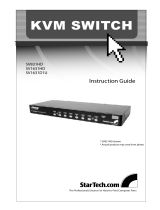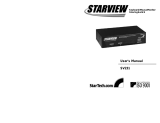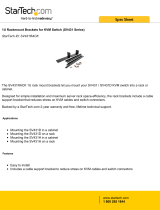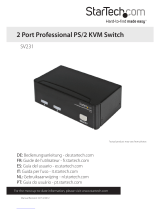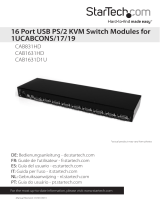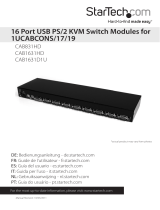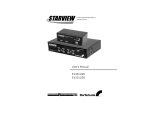Page is loading ...

Keyboard/Mouse/Monitor
SharingSwitch
User'sManual
SV431
SV831
SV431D
SV831D
SV1631D
SV832DS
SV1632DS

Table of Contents
Introduction
Overview 1
Features 2
Configurations 3
Installation
Device Connection 6
Initial Power-Up 8
Optional Rack Mount Accessories 9
Operation
Front Panel Push Buttons 10
OSD (On-Screen-Display) Operation 11
Hot Key Commands 15
Cascade Configuration
Connection 17
Change Configuration while Running 19
Multi-access StarView
Overview 20
Connection 20
Operation 20
Configuration 21
Appendices
Specifications 22
Trouble Shooting 23

1
Introduction
Overview
One-Console StarView Switches
The StarView allows you to access multiple computers from one
keyboard, mouse and monitor. There is no interface card or software
to configure. Installation is as easy as connecting cables between
the StarView and your computers. Operation is as simple as
pressing push button, entering hot-key command and navigating
through the user-friendly on-screen menu (available on models with
OSD support). Depending on the model you have, it switches up to 4
(SV431, SV431D), 8 (SV831, SV831D) or 16 (SV1631D) IBM-
compatible computers. The StarView is independent of the computer
operating system.
Two-Console StarView Switches
The advanced multi-access StarView Switches enable you to control
multiple computers from two different locations, remote and local with
two keyboards, mice and monitors. SV832DS controls 8 computers
and SV1632DS controls 16 computers.
On-Screen Display (OSD) Menu
For SV431D, SV831D, SV1631D, SV832DS, SV1632DS
For StarViews with built-in OSD control, you can name your
computers, switch to a computer from a list, configure settings with
easy-to-use menus, and view the name of the selected computer
on-screen with programmable time interval. The OSD displays the
system status throughout operation.
Automatic Mouse Conversion
The StarView Switch enable you to connect computers with PS/2 or
serial mouse ports (using adapters supplied with each StarView
Switch) and control the computers from one PS/2 mouse.
The StarView automatically identifies the mouse and switches to
proper mouse protocol.

2
High Video Quality
StarView supports VGA resolution up to 1600x1200 @85Hz without
any degradation. Advanced VGA circuit design guarantees smooth
and flicker-free switching from one computer to the other with
distance up to 100ft (30M)* at both Console and PC sides.
NOTE: This User's Manual is written for the following models.
StarView Switch Models
No. of console
supported
1 1 1 2 2
No. of PC supported 4 8 16 8 16
No OSD SV431 SV831 - - -
OSD SV431D SV831D SV1631D SV832DS SV1632DS
· Tested with high-quality UL2919-rated, low-loss and shielded
cables.
Features
nSupports both PS/2 and serial mouse
nCascade configuration expands system capability
nAuto-scan automatically selects computers sequentially
nSupports Microsoft IntelliMouse (Pro)
nHot-key functions allow easy computer access
nKeyboard states automatically saved and restored when switching
computers
nOperating system independent, transparent to all applications
nPlug and play system configuration
nKeyboard and mouse can be hot plugged at any time
nHigh VGA resolution 1600x1200
nDDC2B compatible
nOptional standard 19 inch rack mounting kit available
nSupports optional multimedia module for microphones and stereo
speakers

3
Extra features for On-Screen Display model
nAssign computers with unique and meaningful names
nIdentify and select computers by the names
nProgrammable scan filters unused computers
nStore system settings and name entries to non-volatile memory
nPassword security locks computer from unauthorized access
nGain complete control with easy-to-use OSD interface
More features for multi-access models
nManage multiple computers from two locations
nDifferent Console may have different type mouse i.e. generic PS/2
mouse and scroll button
nSelectable User Timeout
Configurations
StarView has several models each supporting a different number of
computers. For applications with a large number of computers,
StarViews can be cascaded in a master/slave configuration to
support even more computers.
Single StarView Configuration
Connect a PS/2 keyboard, a PS/2 mouse and a VGA multi-sync
monitor directly to the Master’s CONSOLE port. Then, connect
multiple sets of keyboard, mouse and monitor cables to the “PC x”
ports of the StarView, as shown in figure 1.

4
Figure 1: A single StarView configuration
Cascade (Master/Slave) Configuration
You can connect a second level of one or more StarViews to “PC
1”~”PC 4” (SV431) or "PC 1"~”PC 8” ports (SV831 & SV1631) of a
Master unit. Cascade configuration expands system ability allowing
you to select computers connected to the Master or Slaves. There
is only one Master, which has a mouse, a keyboard and a monitor
connected to its CONSOLE port directly operated by a user.
Once connected, StarViews automatically configure themselves to
either Master or Slave. Slaves of different StarView models can be
mixed in cascade configuration. [NOTE: Master must have equal or
more PC ports than that of Slaves, i.e., if SV831 is a master, SV831
and SV431 can be Slaves, but SV1631 can not.]

5
Figure 2: A cascade StarView configuration
Throughout this manual, Master is the StarView that has a
physical keyboard, mouse and monitor connected to its
CONSOLE port. Slave is a StarView that has its CONSOLE port
connected to a Master's “PC x” port. Slave only exists in
cascade configuration.

6
Installation
Device Connection
The monitor connected to the HD-DB-15 VGA port of a Master
CONSOLE must be capable of synchronizing with the computer's
video signal. If you are uncertain about the monitor type, please
consult the monitor user's manual. Connect a PS/2 mouse and a
keyboard to the CONSOLE port marked with a mouse and a
keyboard respectively as shown in figure 3. [NOTE: Only a PS/2
mouse can be connected to the CONSOLE mouse port. The
StarView's automatic mouse conversion system allows you to
connect computers using serial mouse and control the computers
from one PS/2 mouse.]
Figure 3: Master console connection

7
Determine the channel address of each computer. For computers
using PS/2 mouse, connect the computer's mouse and keyboard
cables to the StarView’s connectors marked with a mouse and
keyboard respectively, as shown in figure 4.
Figure 4: Master computer connection
For computers using serial mouse, connect the DB-9 to mini-DIN-6
adapter (supplied with the StarView) to the computer mouse port,
then use PS/2 cables to connect the mouse to StarView, see figure 5.
Connect the computer's monitor cable to the HD-DB-15 VGA
connector. Repeat above steps for all remaining computers to be
connected to the StarView.
Figure 5: Adapter and serial mouse connection

8
Initial Power-Up
Make sure all computers and StarViews are powered down
during installation. You must power up the Master StarView
before turning on any other devices.
4 For single StarView: 1) Apply a power adapter to the Master.
2) Turn on computers.
4 For cascade: 1) Apply a power adapter to the Master.
2) Apply power adapters to all Slaves. 3) Turn on computers.
Note: You may hot plug additional powered-down computer and
Slave without turning any existing StarView or computer off after
initial power up.
Replace Master Console Devices
You can replace a faulty keyboard or mouse of the Master
CONSOLE port at any time without powering down the Master, as
long as your computers are booted with proper device driver for the
new device. Should you encounter any difficulty, just activate K/M
RESET by holding both front-panel ‘1’ and ‘2’ push buttons down for
2 seconds.
Adhesive Rubber Foot
For desktop operation, you may stick the four round rubber feet
(supplied with the unit) to the bottom of the StarView. NOTE: Do not
use the rubber feet for rack mount operation.

9
Optional Rack Mount Accessories
Figure 6 shows how to attach optional mounting brackets to the
StarView unit for standard 19-inch rack cabinet.
Figure 6: Attaching rack mount bracket
Figure 7 shows how to assemble rack cable support then screw it to
the back and inside the rack cabinet vertical post.
Figure 7: Assembling rack cable support

10
Then, keyboard/mouse/monitor cables can be routed over the cable
support. You can use plastic cable ties to bundle and label the
cables through the rack cable support holes for easy identification.
Operation
Front Panel Push Buttons
You may select a computer by pressing the front panel push button
directly, by issuing hot-key commands or by activating the OSD
window (for models with OSD support). The front panel indicator
changes to reflect the computer port selected (red) and whether the
port is connected to a powered computer (green). The indicator
flashes red when it is in either Auto Scan or Manual Scan mode.
Figure 8: Front panel indictor
Some computers support 'keyboard/mouse power up' function, i.e.,
press certain keys or mouse buttons to startup the computers.
Their corresponding green front indicators lit all the time even if the
computers are 'off'.
< K/M RESET
K/M RESET solves most problems developed by keyboard, mouse,
device replacement or change of configuration. Press down both the
front-panel number 1 and 2 push buttons for 2 seconds to
re-configure the whole system without turning either the StarView
Switch or any computer off.
< AUTO SCAN
StarView provides an easy to use feature to start Auto Scanning.
You can press down both the front-panel number 7 and 8 buttons for
2 seconds to start Auto Scanning.

11
OSD (On-Screen-Display) Operation
SV431D, SV831D, SV1631D, SV832DS, SV1632DS
Figure 9: OSD screen illustration
By hitting the left <CTRL> key twice within two seconds, you may see
the 'Hotkey Menu' if it is enabled (an OSD option). Or, by hitting the
left <CTRL> key three times within two seconds, you will see a 'KVM
MENU' screen showing a list of the computers with corresponding
channel addresses, names and status, see figure 9.
The channel address of the currently selected computer is displayed
in red, same as the front indicator, to the right of the OSD title 'KVM
MENU'. The color of a device name is green if it has power and is

12
ready for selection (its corresponding front panel indicator is green),
or the color is white as it has no power. OSD menu updates the color
when it is activated. Use the <UP> and <DOWN> arrow keys to
highlight a computer and the <ENTER> key to select it. Or, you may
press <ESCAPE> to exit OSD and remove the OSD menu from the
display; the status window returns to the display and indicates the
currently selected computer or operating status.
A triangle mark (4) to the right of a name indicates the port is
cascaded to a Slave; the number at the left of the triangle mark
shows the number of ports the Slave has, i.e. 84for SV831D.
<ENTER> key brings you one level down and another screen pops
up listing the names of the computers on that Slave. The name of
the Slave will be shown at the upper right corner of the OSD menu.
It is useful to group computers and still be able to see the
group name.
An eye mark (N) to the right of a name indicating the computer is
selected to be monitored in Scan mode. In OSD, this mark can be
switched on or off by function key <F2>.
Press <ESCAPE> key to exit OSD and to return to the selected
computer; the computer name is also shown on the screen.
=Function key <F1>: To edit name entry of a computer or a Slave.
First, use the <UP> and <DOWN> arrow keys to highlight a channel
then press <F1> followed by name entry. Valid characters are ‘A’~’Z’,
‘0’~’9’ and the dash character. Lowercase letters are converted to
uppercase ones. Press <BACKSPACE> to delete a letter one at a
time. Non-volatile memory stores all name entries until you change,
even if the unit is powered down.
=Function key <F2>: To switch the eye mark (N) of a computer on
or off. First, use the <UP> and <DOWN> arrow keys to highlight it,
then press <F2> to switch its eye mark on or off. If Scan Type is
'Ready PC +
N', only the power-on and eye mark selected
computers will be displayed sequentially in Scan mode.

13
=Function key <F3>: To lock a device (a computer or a Slave)
from unauthorized access, use Security. Security is effective for only
one device (a computer or a Slave). To lock a device, use the <UP>
and <DOWN> arrow keys to highlight it, then press <F3>. Now, enter
up to 4 characters (‘A’~’Z’, ‘0’~’9, ‘-‘) followed by <ENTER> as new
password. A Security-enabled device is marked with a lock (Ï)
following its channel number. To permanently disable the security
function from a locked device, highlight it, press <F3> then enter
the password.
If you want to access the locked device temporarily, simply highlight it
and press <ENTER>, the OSD will ask you for the password.
After entering correct password, you are allowed to use the device.
This device is automatically re-locked once you switch to another
one. During Scan mode, OSD skips the security-enabled device.
NOTE: Only one device (a computer or a Slave) can be locked by
this function at a time.
If you forget the password, the only way to permanently
disable the security function is to remove all possible
power sources from the master StarView. You need to
turn off all computers and unplug all power adapters, then
restart everything.
=Function key <F4>: More functions are available by hitting <F4>.
A new screen pops up displaying more functions as described below.
Most of them are marked with a triangle (4) indicating there are
options to choose from. Using the <UP> and <DOWN> arrow keys,
select the functions and press <ENTER>.
Available options will be shown in the middle of the screen.
Again, using the <UP> and <DOWN> arrow keys to view options
then press <ENTER> to select it. You can press <ESCAPE> to exit
at any time.
< Auto Scan
In this mode, the StarView automatically switches from one power-on
computer to the next sequentially in a fixed interval. During Auto

14
Scan mode, the OSD displays the name of the selected computer.
When Auto Scan detects any keyboard or mouse activity, it suspends
the scanning till activity stops; it then resumes with the next computer
in sequence. To abort the Auto Scan mode, press the left <CTRL>
twice, or, press any front button. Scan Type and Scan Rate set the
scan pattern. Scan Type (<F4>: More\Scan Type) determines if
scanned computers must also be eye mark selected. Scan Rate
(<F4>: More\Scan Rate) sets the display interval when a computer is
selected before selecting the next one.
< Manual Scan
Scan through power-on computers one by one by keyboard control.
Scan Type (<F4>: More\Scan Type) determines if scanned
computers must also be eye mark selected. Press the up arrow key
(
á) to select the previous computer and the down arrow key (â) to
select the next computer. Press any other key to abort the Manual
Scan mode.
< Audio Stick
An optional multimedia module can be LINKed to the back of each
StarView for selecting microphone and stereo speaker signals.
There are two options for Audio Stick: ON and Off. When set to 'On',
audio selection follows computer selection. When set to 'Off', audio
selection stops following computer selection. It is useful if you want
to listen to a particular computer's audio signal while operating other
computers. The non-volatile memory stores the Audio Stick setting.
< Scan Type
Ready PC +N: In Scan mode, scan through power-on and eye mark
selected computers.
Ready PC: In Scan mode, scan through power-on computers.
The non-volatile memory stores the Scan Type setting.
< Scan Rate
Sets the duration of a computer displayed in Auto Scan mode.
The options are 3 seconds, 8 seconds, 15 seconds and 30
seconds. The non-volatile memory stores the Scan Rate setting.
< Keyboard Speed

15
StarView offers keyboard typematic setting that overrides the similar
settings in BIOS and in Windows. Available speed options are Low,
Middle, Fast and Faster as 10, 15, 20 and 30 characters/sec
respectively. The non-volatile memory stores the Keyboard
Speed setting.
< Hotkey Menu
When you hit the left <CTRL> key twice within two seconds, the
"Hotkey Menu" appears displaying a list of hot-key commands if the
option is On. The 'Hotkey Menu' can be turned Off if you prefer not to
see it when the left <CTRL> key is hit twice.
The non-volatile memory stores the Hotkey Menu setting.
< CH Display
Auto Off: After you select a computer, the channel address and
name of the computer will appear on the screen for 3 seconds then
disappear automatically.
Always On: The channel address and name of a selected computer
and/or OSD status displayed on the screen all the time.
The non-volatile memory stores the CH Display setting.
< Position
The position of the selected computer name and/or OSD status
displayed on screen during operation. The actual display position
shifts due to different VGA resolution, the higher the resolution the
higher the display position. The non-volatile memory stores the
Position setting.
UL as Upper Left, UR as Upper Right,
LL as Lower Left, LR as Lower Right.
MI as MIddle,
=ESC: To exit the OSD, press the <ESCAPE> key
Hot-key commands
Hot-key command is a short keyboard sequence to select a
computer, to activate computer scan, etc. StarView interprets

16
keystrokes for hot-keys all the time. A hot-key sequence starts with
two left <CTRL> keystrokes followed by one or two more keystrokes.
A built-in buzzer generates a high-pitch beep for correct hot-key
command; otherwise, one low-pitch beep for error and the bad key
sequence will not be forwarded to the selected computer.
The short form hot-key menu can be turned on as an OSD function
(<F4>: more\Hotkey Menu) every time the left <CTRL> key is
pressed twice.
L-CTRL: is the <CTRL> key located at the left side of the keyboard.
1~8/A~H: are the number keys '1' ~ '8' at the upper row of the
keyboard and character keys 'A' ~ 'H' case insensitive. Do not use
the keypad at the right of the keyboard.
g To select a computer by hot-key command, you must know its
channel address, which is determined by the StarView connection.
For a computer connected to a Master, its address is represented by
the PC port label (1~8 or A~H). For a computer connected to a
Slave, two characters represent its address. The first character is the
channel address of the Master unit (1~8) and the second one is the
channel address of the Slave (1~8 or A~H). Please note that only
Master's 'PC 1' ~'PC 8' ports can be connected to a Slave.
Left Ctrl + left Ctrl + 7
Selects a computer connected to port 7 of the Master.
Left Ctrl + left Ctrl + 6 + C
Selects a computer connected to port C of a Slave connected to port
6 of the Master.
g To start Auto Scan, automatically scan power-on computers one
by one at a fixed interval:
left Ctrl + left Ctrl + F 1
When Auto Scan detects any keyboard or mouse activity, it
suspends the scanning till activity stops; it then resumes with the next
computer in sequence. The length of the Auto Scan interval (Scan
Rate) is adjustable, see below. To abort the Auto Scan mode, press
the left Ctrl key twice.
Note: For OSD models, Scan Type determines whether eye mark
is necessary during Auto Scan.

17
g Manual Scan enables you to manually switch back and forth
between power-on computers.
left Ctrl + left Ctrl + F2
Press áor âto select the previous or the next computer in sequence.
And, press any other key to abort the Manual Scan.
Note: For OSD models, Scan Type determines whether eye mark is
necessary during Manual Scan.
g To adjust Scan Rate which sets the duration before switching to
the next computer in Auto Scan:
left Ctrl + left Ctrl + F3
The StarView sends one to four beeps indicating scan interval of 3, 8,
15 and 30 seconds respectively.
g To adjust keyboard typematic rate (characters/sec), this setting
over-rides that of BIOS and any operating system:
left Ctrl + left Ctrl + F4
The StarView generates 1 to 4 beeps corresponding to 10, 15, 20
and 30 characters/sec respectively.
g Audio Stick
An optional multimedia module can be LINKed to the back of each
StarView for selecting microphone and stereo speaker signals.
There are two options for Audio Stick: ON and Off. When set to 'On',
audio selection follows computer selection. When set to 'Off', audio
selection stops following computer selection. It is useful if you want
to listen to a particular computer's audio signal while operating
other computers.
left Ctrl + left Ctrl + F5
The StarView generates 1 or 2 beeps corresponding to On and
Off respectively.
Cascade Configuration
Connection
Before connecting a device (a computer or a Slave) to the Master
under power, you must turn off the device. The Master must have

18
equal or more 'PC x' ports than that of the Slave, i.e., if SV831
is the master, SV831 and SV431 can be Slaves, but SV1631 can not.
The ports labeled "PC 1"~”PC 8” can be connected to either a
computer or a Slave's CONSOLE port, as shown in figure 10.
The ports “PC A"~”PC H” can only be connected to a computer.
A power adapter with DC 9V/500mA output rating must be connected
to the Master.
Figure 10: Slave console connection
The maximum number of computers controlled by a master/slave
configuration with all SV431s is 16 with 4 Slaves and each Slave
connects to 4 computers, see figure 11. For an all SV831s
configuration, the number is 64 with 8 Slaves and each Slave
connects to 8 computers, see figure 12. For an all SV1631
configuration, the number is 136, see figure 13. The Master SV1631
connects to 8 Slaves and 8 computers, and each Slave connects
to 16 computers.
/
